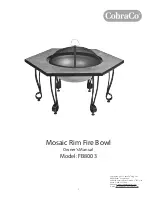
7
INSTALLATION USING A PROPANE SUPPLY TANK(S)
1) When installing the heater for use with propane gas, set the gas selector to “Propane”
and lock in position.
2) The propane supply system must be set up for vapor withdrawal from the operating tank(s).
Liquid Propane can cause the heater to overfire and will damage valve train components.
3) The heater must be located at least 6 ft from any LP-Gas container, and not directed toward any
LP-Gas container within 20 ft.
4) Minimum Tank Size
Outdoor Temperature
500 Gal.
Above +25˚F
1000 Gal.
+25˚F to + 10˚ F
2 x 1000 Gal.
Below +10˚F
5) The installation must conform with local codes, or in the absence of local codes, with the
Standard for Storage and Handling of Liquefied Petroleum Gasses ANSI/NFPA 58.
6) Turn off the propane supply valve at the tank(s) when the heater is not in use.
7) When the heater is to be stored indoors the propane tank(s) must be disconnected from the
heater and the tank(s) stored in accordance with Chapter 5 of the above National Standard.
COMMON INSTALLATION AND OPERATIONAL PROBLEMS
1) LOW VOLTAGE AT THE HEATER
This is one of the most common problems and is usually the result of the supply cord having
too small a wire gauge for its length, or low voltage at the power source. Low voltage results in
the motor overheating, burnt relay contacts, or a relay that will not make contact. Check
voltmeter on heater before start-up.
2) SUPPLY LINE TOO SMALL
See reference hose chart on page 6.
3) INSUFFICIENT VAPORIZATION AT SUPPLY
Normally caused by undersized supply tank.
4) IMPROPER GAS SUPPLY PRESSURE
Usually a result of propane supply pressure being too high because of improper or lack of
regulation or too low of natural gas pressure at meter.
5) DIRTY GAS SUPPLY
Dirty gas can cause strainers to plug or form a build-up in the burner orifice.
6) LACK OF PREVENTIVE MAINTENANCE
Heaters must be cleaned as required, especially when used in a dirty environment.
7) IMPROPER SUPPLY OF FRESH AIR
It is strongly recommended that the intake air of the heater be taken from outside the enclosed
area. This provides a slight pressurization and prevents any problems associated with
recirculation of products of combustion.
Summary of Contents for 1800
Page 16: ...16 Note New Fenwal Control Board ...
Page 18: ...18 ...






































